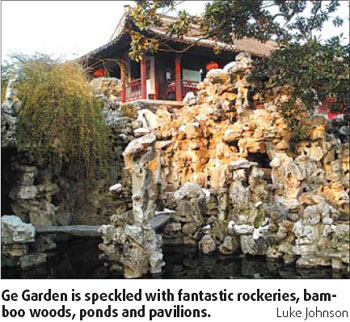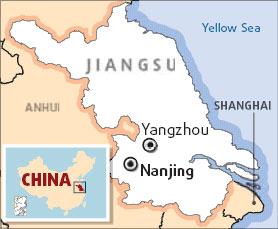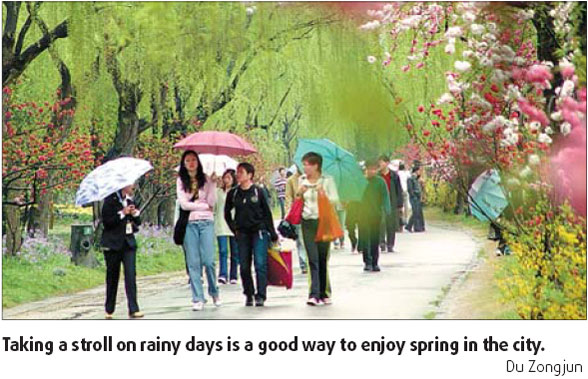Park life
|
Flowers bloom near Slim West Lake, an icon of Yangzhou. Hu Zhenling |
Gu ren xi ci huang he lou, Yan hua san yue xia yang zhou. (An old friend left Huanghe Tower, To visit Yangzhou in the lovely spring.)
These lines were penned by the poet Li Bai in the 7th century. Fourteen centuries later, they capture the allure of Yangzhou's refined beauty. Its elegant landscape and the aesthetic lifestyle have made the ancient eastern city a perfect testament to how crafty the art of enjoying life can be.
I arrived in Yangzhou in early February, just as the weather was getting warmer after weeks of heavy snow. Steady drops of water glistened in the morning sun as the melting snow dripped down the centuries-old pavilion-style eaves curling to the skies.
I was born in this town of Jiangsu province. Although I never spent much time here, I've always felt connected with it in indefinable ways, and I usually spend the holidays with my relatives here. Before the Chinese New Year festivities kicked into gear, I found some time to revisit the gardens where I'd roamed as a child.
I started with Slim West Lake (Shou Xihu) park, an icon of the city's southern beauty.
The park is the epitome of a Chinese garden, and mentioning its name to Yangzhou locals invokes images such as sunlight sifting through weeping willows, a hidden corner of a rock garden, and a secret cave view of the moon.
I rented a boat and paddled under five-pavilion bridge and along the narrow waterway (hence the "slim"). It is said the bridge was designed so that five reflections of the moon can be seen under the five arches when the moon is full.
The famous willow-lined dykes and the cherry blossoms weren't yet in season, but it wasn't hard to remember its spring glory from the iridescent lake and the balmy weather.
Next was Ge Garden, built in 1818 during the Qing Dynasty (1644-1911) by a rich salt merchant. The small private garden is speckled with fantastic rockeries, bamboo woods, ponds and pavilions.
The peculiar rock pilings (jia shan in Chinese) reach up to 40 m tall, and they contain caves, bridges, secret pathways and lookouts. The rockeries are divided into four sections depicting scenes from the four seasons.
The autumn section, for example, is built with sharp-edged yellow rocks from Huangshan Mountain to portray the loftiness of the fall landscape, and Japanese maples thrive in the cracks between the rocks.
Although each section occupies no more than a dozen square meters, these intricately designed structures seem to create space within, and you can spend a long time walking every path and wandering through the caves.
The picturesque rockeries were my private garden 20 years ago. You're not allowed to climb the rocks these days, but back then it was a wonderland full of danger and thrills for a child. The mountaineering was quite challenging, but the grand view from the top is something today's law-abiding citizens will never know.
To a child, the playful qualities of the rocks overshadowed the aesthetic values of the bamboo, but according to legend, the owner named the Ge Garden as such because the Chinese character ge resembles bamboo, the upright character which he regarded highly.
The city is dotted with gardens like this, as Yangzhou has been a commercial center since the 7th century AD and was home to many wealthy merchants who built these private gardens so they could enjoy the finer things in life.
For many modern Yangzhou people, two of life's finest things are dining out and going to the bathhouse.
As the city dwellers have become richer, dining out has become the norm when it comes to celebrating holidays and getting together. The restaurant industry is hot here, and there is a constant shortage of related services even though there are no less than a dozen fancy restaurants on every major street.
Yangzhou cuisine is representative of the culinary cultures of the Yangtze and Huaihe river region. Local delicacies include "lion's head" meatball stew (hong shao shi zi tou), boiled sliced tofu (da zhu gan si) and stir-fried shrimp (chao xia ren). Yangzhou dumplings (baozi) and Yangzhou fried rice (Yangzhou chao fan) have also gained global popularity comparable to sweet and sour pork.
The city's other favorite pastime involves going to public bathhouses. It's nothing like the morning shower you're used to - in Yangzhou, personal hygiene is a social event for friends and relatives to catch up.
Common bathhouse activities also include massages, manicure and pedicure. In fact, one of Yangzhou's famous "three knives" is a kind of carving knife used by a pedicurist to cut out corns on the feet. The other two are the kitchen knife and scissors.
While shopping centers and karaoke bars occupy much of the new city, the old town section of Yangzhou is characterized by old-fashioned courtyards and cobblestone alleys.
 Some of the alleyways are so narrow that only one person can pass through it at a time. If you're a good rider you can ride a bike through it as well. But if there's another bike coming from the opposite direction, one of you will have to concede and back up.
Some of the alleyways are so narrow that only one person can pass through it at a time. If you're a good rider you can ride a bike through it as well. But if there's another bike coming from the opposite direction, one of you will have to concede and back up.
It doesn't take long for the intimate charms of the city to grow on you. Like Beijing, Yangzhou has thousands of years of history as a cultural center. But while Beijing expanded to impossible proportions, Yangzhou kept a modest population and the town is small enough to know your way around after a couple of days.
The Jinghang (Bejing-Hangzhou) Grand Canal that runs through the city is a good landmark to follow. The ancient waterway was first constructed in 486 BC, and it stretches 1,800 km from Zhejiang province's Hangzhou city all the way north to Beijing.
Yangzhou is a city with history. Italian traveler Marco Polo served in Yangzhou as an official from 1281 to 1287. Many classic poets have also paid tribute to the beautiful city in their verses that remain popular today.
During the Qing Dynasty, a group of painters in Yangzhou sought breakthroughs in their art. For their radical rejection of traditions and innovative spirit, they were named the "eight eccentrics" and are commemorated by locals till this day.
But instead of being burdened by the past, Yangzhou people find ways to keep it alive.
Traditional Chinese art such as calligraphy, brush painting and guzheng (an ancient plucked instrument) thrive in this city. Usually regarded as hobbies of retirees in Beijing, these traditional art forms are taken seriously here by both the young and old.
Even though I have been away for so many years, I still feel part of the tight-knit community that is deeply aware of its historic roots. I am proud of this beautiful city and feel fortunate to call it home.

(China Daily 03/06/2008 page19)















